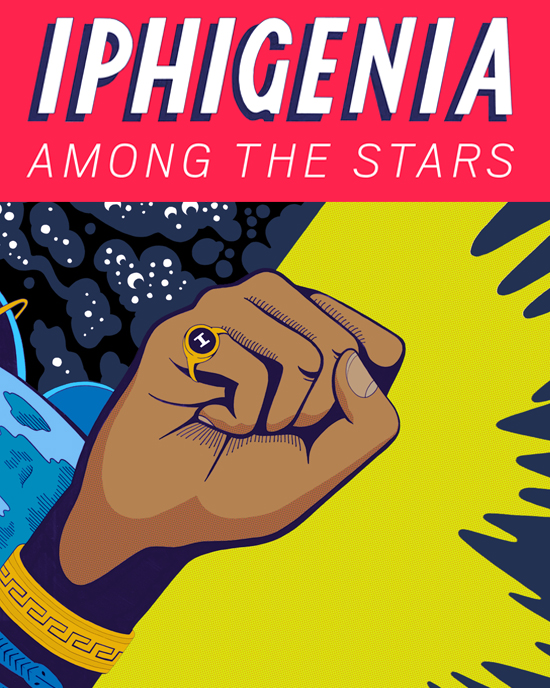The Island, the second show of the Yale Cabaret’s spring semester, is a powerful two-man play, directed by Kate Attwell and featuring Paul Pryce (John) and Winston Duke (Winston). The play was written by Athol Fugard in collaboration with the actors—John Kani and Winston Ntshona—who initially played in it. As prisoners in a South African prison known as “the island,” the two men’s crimes, we can assume, are political, and thus their bond is based on the deprivations of their condition. We meet them as they return to their cell, winded from running, injured, exhausted. As unlikely as it might seem, much of their interaction will be about their plan to present a performance of Sophocles’ Antigone in a show for the other prisoners.
Staged with the actors on a platform flanked by comissary-style tables and with chairs at the head and foot, the space is intimate and the actors, as they loom above us, seem at times larger-than-life. It’s an interesting means to create a heroicizing perspective on the two men as they work out their production, which entails Winston, as Antigone, having to don a wig of straw and a bra with tins for cups. He rebels against the affront to his dignity and must be placated by John, who is determined that Antigone be presented, to lodge the theme of blood ties and honor against the dehumanizing demands of the State.
What carries the play and makes it riveting throughout is the interplay between Pryce and Duke. Fully immersed in their parts, they establish the sense of familiarity between the men, due to intimate proximity, but also the degree to which they are quite different in their attitudes and expectations. That difference becomes paramount when John learns that he will be released in three months’ time. Their shared elation swiftly becomes a deeply moving nostalgia for the time they shared together and then, gradually, a sense of dejection and even resentment on Winston’s part, even as John keeps insisting he doesn’t want to think about his release—that it might be all a trick.
What isn’t a trick is the extent to which playacting is a part of the prisoners getting through their ordeal. Early on John acts out imaginary phone calls to friends back home and to the two men’s wives. The scene quickly establishes the power and fascination of make believe—the power of suggestion comes out in the playacted phone call, in the reminiscences of the day they were incarcerated together, and in Winston’s projections of what life will be like for John when he returns home. Fugard makes all this take place in dialogue between two half-naked men, with little in the way of props or theatrical tricks. The Island demonstrates effectively that the best drama takes place in our heads while listening to characters talk.
The staging of Antigone is a significant change of scene: Pryce as John as King Creon and Duke as Winston as Antigone prowl the walk space behind the tables, moving about as if sizing each other up for a duel to the death. The fact that John, who has been approved for release, should have the role of the State questioning Winston as the defiant Antigone—who insists on burying her brother, condemned as a traitor, though the law forbids it—makes the playacting reflect a struggle between the two men as well. John, as the one who initially quizzes Winston on the parts they will play and who seems the more articulate and quick-witted, becomes, by means of the play, a further goad and even persecutor of his cellmate. Winston, then, as Antigone—the gender roles also are relevant—must give voice to a defiance that stands for the enemies of the State of Apartheid, but also for those oppressed by the constructions placed upon them by others.
The play creates a subtle relation between the two men and Pryce and Duke bring home the passion, power and dignity of these men with great skill. The show’s design, use of song—via “Singers from Shades”—and lighting combine to create one of those Cab shows that reinvents the space and the audience’s relation to the spectacle a bit as well. The Island is a commanding production.
The Island By Athol Fugard, John Kani, and Winston Ntshona Directed by Kate Attwell
Assistant Director: Gabriel DeLeon; Scenic Designer: Kristen Robinson; Costume Designer: Seth Bodie; Lighting Designer: Oliver Wason; Sound Designer: Matt Otto; Stage Manager: Louisa Balch; Producer: Lico Whitfield; Singers from the Shades: Carol Crouch, Edwina Kisanga, Dianne Lake, Ian Miller, Naima Sakande
The Yale Cabaret 217 Park Street January 24-26, 2013
The Cab will be dark for two weeks, then return on Valentine's Day weekend with Ermyntrude and Esmeralda, a naughty puppet-play by way of an Edwardian novella by Lytton Strachey.
